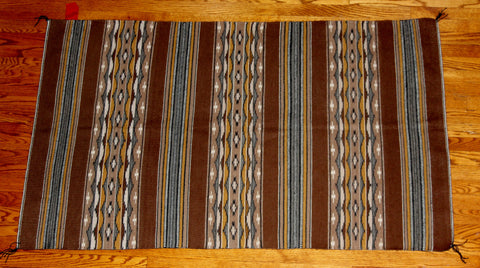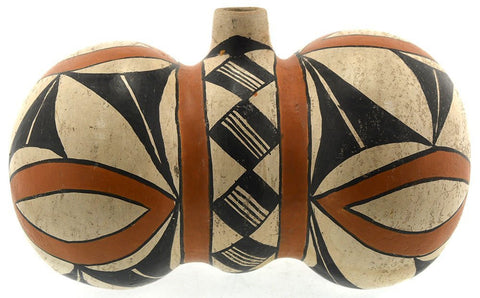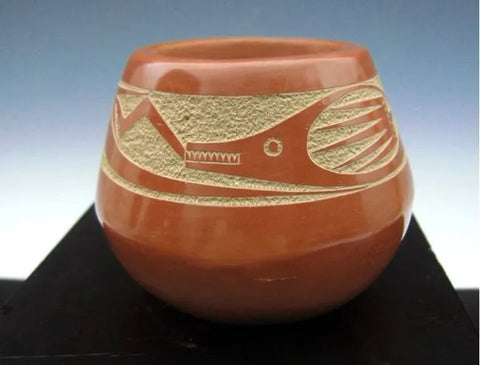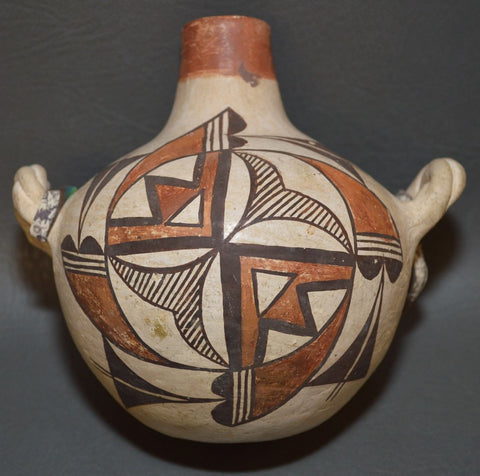
Southwest Pottery : Native American Hopi Pottery Seed Pot, by Feather Woman, Sylvia Naha #16
$ 1,400.00
Native American
Hopi Pottery by Feather Woman
16. Native american, Hopi pottery by Feather Woman-Sylvia Naha (1951-1999) was a well known Hopi potter who incorporated her own designs mixed with her Mothers designs. Beautifully hand painted seed pot. Shows no damage. Mint condition.
Dimensions: 5 1/2" dia., 4 3/4" tall.
Sylvia Naha, daughter of Feather Woman, first made pottery when she played with the adobe in her father's field below Awatovi. One day, her father plowed up a pot with a swirling geometric design. Since then, it has become a Naha family design. Sylvia paints free hand, using yucca brushes and the butt of a wooden matchstick for stippling. Her mother told her, Never leave anything out in your design or your process.
Sylvia signs her pottery with a feather and the initials and lot of my designs are in part some of Mom's (Helen Naha), and I just mix them. There are about five designs of hers I use in different ways. Sometimes I used to cover up crooked designs and fit others to it.
I am starting to mix my designs with more traditional designs. A lot of people like the animal designs and a lot like the traditional, so I mix them. People like to see a lot of fine-line and others like simplicity. I like to bounce back and forth to make something eye pleasing. I use them to make something someone will like.(Source: tannerchaney)
A History of Pueblo Pottery:
“Pueblo pottery is made using a coiled technique that came into northern Arizona and New Mexico from the south, some 1500 years ago. In the four-corners region of the US, nineteen pueblos and villages have historically produced pottery. Although each of these pueblos use similar traditional methods of coiling, shaping, finishing and firing, the pottery from each is distinctive.
Various clay's gathered from each pueblo’s local sources produce pottery colors that range from buff to earthy yellows, oranges, and reds, as well as black. Fired pots are sometimes left plain and other times decorated—most frequently with paint and occasionally with appliqué. Painted designs vary from pueblo to pueblo, yet share an ancient iconography based on abstract representations of clouds, rain, feathers, birds, plants, animals and other natural world features.
Tempering materials and paints, also from natural sources, contribute further to the distinctiveness of each pueblo’s pottery. Some paints are derived from plants, others from minerals. Before firing, potters in some pueblos apply a light colored slip to their pottery, which creates a bright background for painted designs or simply a lighter color plain ware vessel. Designs are painted on before firing, traditionally with a brush fashioned from yucca fiber.
Different combinations of paint color, clay color, and slips are characteristic of different pueblos. Among them are black on cream, black on buff, black on red, dark brown and dark red on white (as found in Zuni pottery), matte red on red, and polychrome—a number of natural colors on one vessel (most typically associated with Hopi). Pueblo potters also produce undecorated polished black ware, black on black ware, and carved red and carved black wares.
Making pueblo pottery is a time-consuming effort that includes gathering and preparing the clay, building and shaping the coiled pot, gathering plants to make the colored dyes, constructing yucca brushes, and, often, making a clay slip. While some Pueblo artists fire in kilns, most still fire in the traditional way in an outside fire pit, covering their vessels with large potsherds and dried sheep dung. Pottery is left to bake for many hours, producing a high-fired result.
Today, Pueblo potters continue to honor this centuries-old tradition of hand-coiled pottery production, yet value the need for contemporary artistic expression as well. They continue to improve their style, methods and designs, often combining traditional and contemporary techniques to create striking new works of art.” (Source: Museum of Northern Arizona)
----------
View the other items in my shop: http://www.etsy.com/shop/CulturalPatina?ref=shopsection_shophome_leftnav




